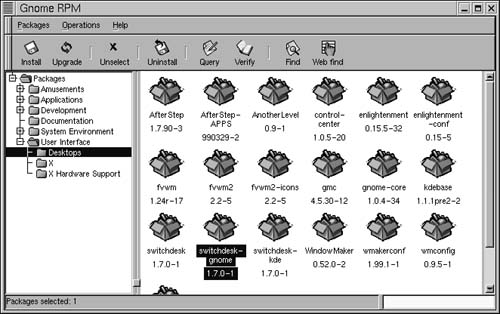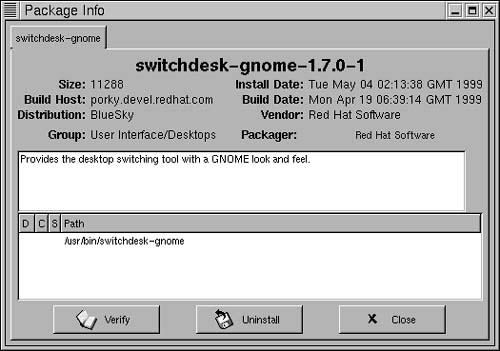Logon Screen Options
In Red Hat Linux's default configuration, the system boots to a graphical desktop environment. (For more information on how this is configured, see Chapters 1 through 3.) If you've left your system configured this way, when you turn it on, after various processing steps, the Red Hat Linux 6 logon screen will appear.
Figure 6.1. You can click Options on the logon screen to select the Session, Language, or System option.

As its name implies, you use this screen to enter your logon identification and password. In addition, using the fly-out menus that appear when you click the Options button, you can:
Choose a session, meaning either a desktop environment or a terminal-like Failsafe command-line mode.
Use the System menu to reboot or shut down.
Select the language that many of the desktop environment menus and objects—such as buttons—will use.
You should also know that when you log off from a desktop environment, the Red Hat Linux 6 logon screen will appear.
Sessions options
Sessions options determine which shell Red Hat Linux 6 will start with.
To choose a session:
1. | When the Red Hat Linux 6 logon screen appears, click the Options button. A fly-out menu with the choices Sessions, Languages, and System will appear (Figure 6.1). |
2. | To access the Sessions menu items, pass your mouse over the word Sessions. A new fly-out menu with five choices will appear (Figure 6.1). |
3. | Click the session of your choice. |
4. | Enter your logon ID. |
5. | Press the Tab key to move to the Password field. |
6. | Enter your password. |
7. | Click OK. |
Tip
You can enter your logon ID and password either before or after you make selections from the Options menus.
Tip
Your password will not appear on the screen as you type it.
Tip
If you choose Failsafe, a command-line interface will open (see the following paragraphs).
Tip
The default environment is the Gnome desktop environment. (For instructions on changing the default logon session, see "To change the default desktop" later in this chapter.)
Failsafe mode
Failsafe mode is a text-based interface that appears at the bottom right of the logon screen (without the logon box). It allows you to directly enter Linux commands at the prompt.
Because X-Windows servers do not need to operate for Failsafe mode to work, if your system gets as far as the logon screen, it is almost certain that Failsafe mode will start. Thus, if your computer won't boot into a windows environment, but you can get your computer as far as the logon screen, Failsafe mode can be used to debug the problem.
Of course, you may never need Failsafe mode. But, if you do, for information on working directly with Linux commands, see Chapters 9 through 12 and Appendix A.
To return to the logon screen from Failsafe mode:
-
At the prompt type exit. The Logon screen will reappear.
To change the default desktop:
1. | Start the Gnome desktop environment. |
2. | Open the Gnome main menu. |
3. | Choose Gnome Desktop Switcher from the System fly-out menu. The Desktop Switcher dialog box will open (Figure 6.2). Figure 6.2. You can use the Desktop Switcher to set the default desktop by making sure that Change Only Applies to Current Display is not selected
|
4. | Using the radio buttons, select the desktop you want from the Available Desktops list. |
5. | Make sure the Change Only Applies to Current Display option is not selected. |
6. | Click OK. |
Tip
For more information on using the Desktop Switcher, see Chapter 3.
Adding the Desktop Switcher
If you can't find the Desktop Switcher on the System menu, that doesn't mean that the utility hasn't been installed on your system.
If it is present on your system, you can add it to your System menu by following these steps:
Locate the Desktop Switcher's command line invocation.
Use the Menu Editor to add the Desktop Switcher's command-line invocation as an item on the System menu.
To verify that Desktop Switcher has been installed if there is no menu item for it:
1. | Open the Gnome main menu. |
2. | Choose GnoRPM from the System fly-out menu. The Gnome RPM window will open. |
3. | Expand the Package hierarchy pane on the left of Gnome RPM so that Desktops (under User Interface) is selected (Figure 6.3). Figure 6.3. You can use Gnome PRM to see if a particular package was installed.
You will see the installed desktop packages listed in the right pane. |
4. | Highlight the package labeled switchdesk-gnome. |
5. | Click the Query button on the Gnome RPM toolbar. The Package Info window will open (Figure 6.4). Provided that the Desktop Switcher has been installed, the Package Info window will provide a description of the application and the path for the command-line invocation of the application. Figure 6.4. The Package Info window will tell you an application's command path.
|
6. | Make a note of the Desktop Switcher's path: /usr/bin/switchdesk-gnome. |
. | Click Close to close the Package Info window. |
7. | Choose Quit from the Gnome RPM Packages menu to close Gnome RPM. |
Tip
Using the command-line invocation for the Desktop Switcher, you can start the Desktop Switcher in a terminal window or in Gnome File Manager, or by adding it to the Gnome main menu as described in the next section.
Tip
For more information on using Gnome RPM, see Chapter 3.
To add the Desktop Switcher to the Gnome System menu:
1. | Make sure you are logged on as root. |
2. | Choose Menu Editor from the Settings fly-out of the Gnome main menu. The Gnome Menu Editor window will open. |
3. | In the left pane, select the System folder. |
4. | Click the New Item button. A new, untitled item will be added to the System folder, with a Property dialog box displayed in the right pane (Figure 6.5). Figure 6.5. If you know a program's command path, you can add it as an item to a Gnome menu using the Menu Editor.
|
5. | |
6. | In the Command box, enter the command line you found in Gnome RPM: /usr/bin/switchdesk-gnome |
7. | Click Save. |
8. | Close the Menu Editor window. Gnome Desktop Switcher is now added to your System menu fly-out. |
Tip
For more information on working with the Gnome Menu Editor, see Chapter 3.
System options
The logon screen System fly-out menu items are used to reboot and shut down your system.
To reboot your system:
1. | When the Red Hat Linux 6 logon screen appears, click the Options button. A fly-out menu with the choices Sessions, Languages, and System appears. |
2. | To access the System menu items, pass your mouse over the word System. A fly-out menu with two choices appears. |
3. | Click Reboot. A box will appear asking if you really want to reboot the machine. |
4. | Click Yes. |
Tip
This is the equivalent of entering shutdown –r now at a command prompt.
To shut down your system:
1. | When the Red Hat Linux 6 logon screen appears, click the Options button. A fly-out menu with the choices Sessions, Languages, and System appears. |
2. | To access the System menu items, pass your mouse over the word System. A fly-out menu with two choices appears. |
3. | Click Halt. A box will appear asking if you really want to halt the machine. |
4. | Click Yes. |
Tip
This is the equivalent of entering shutdown –h now at a command prompt.
Language options
You can choose a language from the extensive list on the Languages fly-out menu. The language you select is then used to build the text of menu items, dialog boxes, and windows bars. But no matter the language, some desktop environment elements are still displayed in English.
To display the desktop in French:
1. | When the Red Hat Linux 6 logon screen appears, click the Options button. A fly-out menu with the choices Sessions, Languages, and System will appear. |
2. | To access the Languages menu items, pass your mouse over the word Languages. A new fly-out menu with a long list of languages will appear. |
3. | Click French. |
4. | Enter your logon ID. |
5. | Press the Tab key to move to the Password field. |
6. | Enter your password. |
7. | Click OK. The desktop environment will appear using French instead of English in many places (Figure 6.6). |
Figure 6.6. The language you select is used to build your desktop environment.

Tip
Once you select a language, it becomes the default language until you select another language.




